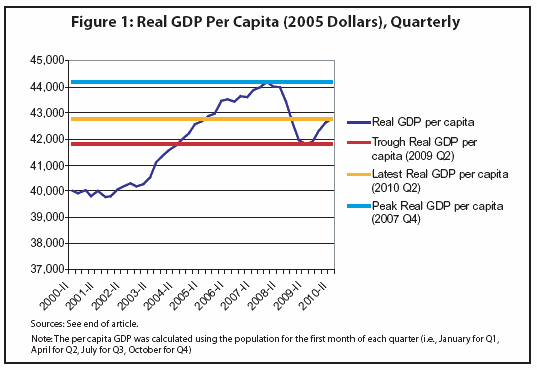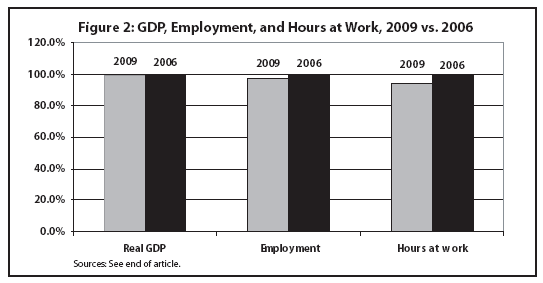Where Have All the New Jobs Gone?
Job creation has come to a near halt. What explains employers’ reluctance to create new jobs in an expanding economy?
Today's economic crisis is less about the quantity of output than the distribution of income and leisure.
During the current crisis, real (inflation-adjusted) GDP per capita for the United States economy declined for six consecutive quarters. It has since increased for four consecutive quarters, though the figure for the second quarter of this year remains well below the pre-crisis peak. This might seem like an indication that real GDP per capita is a good measure of economic well-being. We're in a severe crisis, everyone thinks things are bad, and GDP is down. Even though GDP has been growing again recently, we're still not back to the level of prosperity before the crisis.
Consider, however, that real GDP per capita for the second quarter of 2010 was higher than it was in the second quarter of 2005--and in fact for every previous quarter in U.S. history. Now, hardly anyone thinks that things are better in the United States today, economically, than they were in 2005--or that, excepting about three years between 2005 and 2008, things are better economically now than they have ever been before. It can't be that our only problem is having fewer goods and services (as measured by real GDP per capita), since similar levels back in 2005 were not considered a disaster.
One alternative explanation is that the level of GDP does not matter as much as the change in GDP. Maybe we've gotten used to higher levels of affluence, and now miss the extra goods and services. At first blush, that doesn't seem like the issue either. The difference between the pre-crisis peak in real per capita GDP and even the trough of the recession is surprisingly small, less than 6%. Many people, counting on their incomes not only to remain at the higher (pre-crisis) level but to keep increasing, however, undoubtedly made spending decisions that are now difficult to reverse--like buying a house of a certain size and location or sending one's children to a certain college. Even if the decline in incomes were spread evenly across the population, for those living close to the limits of their means, it might be difficult to "scale back."

Of course, the impact of the recession has not fallen equally on everyone, and that is much closer to the crux of the problem. The unemployed have borne the brunt of the recession. The official number of unemployed people in the U.S. labor force dipped below 6.5 million just before the recession, in the first half of 2007. Today, it stands at nearly 15 million. For the unemployed themselves, this means not only a loss of income but also of an important source of personal identity and self-esteem, of a major part of their social lives, and of future career prospects. For millions of others, mass unemployment means increased insecurity and anxiety about their own futures.
Real U.S. GDP in 2009 was nearly the same as for 2006-just under $13 trillion. (The Bureau of Economic Analysis reports figures of $12.8806 trillion (in 2005 dollars) for 2009 and $12.9762 trillion for 2006). While these measures of total output produced are nearly identical, the figures for the number of workers employed and the number of work hours required to produce that output are strikingly different. In 2006, about 138.7 million workers (16 years and over) were employed, compared to only about 134.4 million in 2009. The total time spent at work, by all workers 16 and over, was about 18 billion hours fewer in 2009 than in 2006.
Producing the same quantity of output in fewer hours means that labor productivity has increased. There are several possible causes: increased intensity or pace of work (or "speed up"), increased worker skill, improved production methods, or greater quantity or quality of tools used. During the current crisis, multiple factors may have been involved. High unemployment itself reduces workers' bargaining power. Employers know that there are plenty of unemployed workers who are desperate for a job. Meanwhile, workers who do have jobs are desperate to keep them. This makes it relatively easy for employers to push down wages or demand a higher pace of work. It may also be that workers' average skill level has increased, if for no other reason than that less-skilled workers are disproportionately represented among those laid off. There may also have been innovation in production methods and technology that explain part of this productivity increase.
Increased productivity is not intrinsically a bad thing. It can mean being able to produce more goods--and a higher "standard of living"--without additional work hours. Increases in productivity have been a major source of economic growth in capitalist economies. As long as demand for goods and services keeps pace with rising productive capacity, productivity increases generally fuel rising real output. In principle, increased productivity can also mean being able to produce the same amount of goods in fewer work hours. Fewer work hours can mean more leisure time and a higher quality of life.

The increase in productivity over the last few years, however, has not been matched by an increase in demand for goods. Overall demand now stands around the same level as a few years ago and at a significantly lower level than at the peak of the last boom, even as overall productive capacity has increased. The managers of capitalist enterprises do not set workers to produce goods just because they can, but because they (the managers) believe that this output can be sold at a profit. The decline in demand, then, means that some productive resources go unused--in the form of shuttered factories and idle machinery, and a dramatic decrease in employment and work hours.
This decline in work hours has not been distributed sensibly or equitably among all members of the population--in the form of a shorter regular working week, more vacation time, or an earlier retirement. Therefore, we have the strange paradox that today the U.S. economy produces about as much output (real goods and services) as it did in 2006, and requires billions fewer work hours to do so, which sounds like a good thing. And yet, as a result, we find ourselves in a disastrous crisis--millions have lost their jobs and main sources of income, while uncounted millions live in fear of a similar fate.
Karl Marx and Friedrich Engels wrote, over 150 years ago, that capitalist economies, in which goods are produced only if they can be sold, and will not be produced at all if they cannot be sold for a profit, had created a new kind of economic crisis: "an epidemic that, in all earlier epochs, would have seemed an absurdity--the epidemic of over-production." Economic crises in previous societies, Marx and Engels understood, had been caused by an inadequate supply of goods, the results of drought, flood, war, and the like. In capitalist societies, for the first time in human history, there appeared crises as a result not of too little productive capacity, but of too much--"too much civilization, too much means of subsistence, too much industry, too much commerce."
Marx and Engels spoke of "too much means of subsistence, too much industry" with a sort of grim irony. They did not mean that there was really too much productive power compared to peoples' needs or wants, but compared to their buying power (what later economists termed "effective demand"). It is certainly questionable whether endlessly producing more goods and services is really the key to making us better off--as opposed to enjoying greater leisure time, a more pleasant environment, greater economic security, less economic inequality, greater autonomy at work, etc. However, there's no reason that the development of greater productive power must exact the enormous toll of human suffering that it can--and, very often, does--in a capitalist economy.
Bureau of Labor Statistics, Labor Force Statistics (CPS), Table A-1, Employment status of the civilian population by sex and age; Bureau of Labor Statistics, Persons at work in agriculture and related and in nonagricultural industries by hours of work, 2006; Bureau of Labor Statistics, Persons at work in agriculture and related and in nonagricultural industries by hours of work, 2009; Bureau of Economic Analysis, Table 1.1.6. Real Gross Domestic Product, Chained Dollars (A) (Q); Census Bureau, Table 1. Monthly Population Estimates for the United States, April 1, 2000, to July 1, 2010; Karl Marx and Friedrich Engels, The Communist Manifesto.